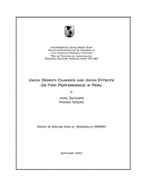Union Density Changes and Union Effects on Firm Performance in Peru
Date
Sep 2002
The paper documents the sharp reduction in union density in Peru between 1986 and 1998, in a context of large macroeconomic fluctuations, structural reforms and changes in the Collective Bargaining Law in 1993. The authors find that a blue-collar job, a permanent contract, higher education and working in a large firm increase the likelihood of unionization, but only before the legislative change. Using a panel of firms for the manufacturing sector for the period 1994-1996, a negative impact of unions on profits for all firm sizes is found. In the econometric analysis, a significant negative effect even after controlling for firm and sector characteristics and firm fixed effects is found. There is some evidence that this effect diminishes over time, consistent with the reduction in union density during that period, but the reduction is not robust to different specifications.



